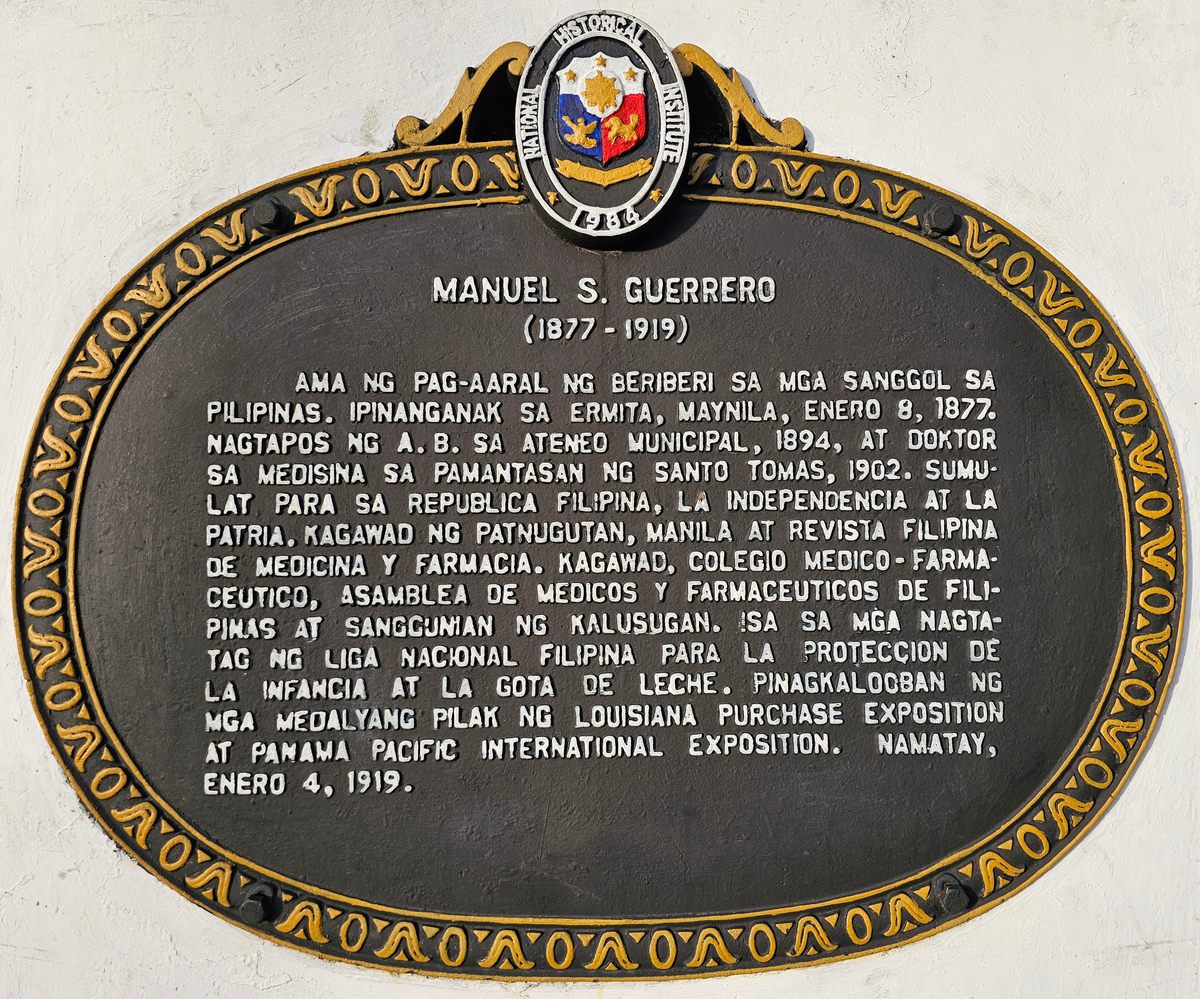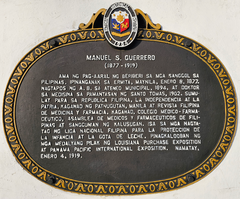
Manuel S. Guerrero Historical Marker Visiting Guide: Metro Manila, Philippines
Date: 14/06/2025
Introduction
The Manuel S. Guerrero Historical Marker is an essential destination for those keen on Philippine history, medicine, and culture. Located in the vibrant heart of Metro Manila, this site honors Dr. Manuel S. Guerrero—a pioneering physician, researcher, and public health advocate whose impact continues to resonate in both scientific and nationalist spheres.
This comprehensive guide details the significance of the marker, provides practical information for visitors, and offers historical context to enrich your experience. Whether you are a history enthusiast, a student, a healthcare professional, or a traveler seeking to understand Manila’s storied past, this guide will help you make the most of your visit.
Why Visit the Manuel S. Guerrero Historical Marker?
The marker stands as a tribute to Dr. Guerrero’s trailblazing work in pediatrics and public health, his advocacy for accessible healthcare, and his involvement in the Propaganda Movement—a powerful confluence of science, education, and nationalism. Visiting the site provides insight into the evolution of Filipino scientific thought and the enduring spirit of reform and resilience that shaped the nation (NHCP, 2024; Evendo: Manuel S. Guerrero Historical Marker; Philstar).
Historical Overview
Who Was Manuel S. Guerrero?
Dr. Manuel S. Guerrero (1877–1919) was a leading Filipino physician, writer, and public health reformer. A specialist in pediatrics, he was among the first to address and reduce the high infant mortality rate in the Philippines, notably through research on beriberi. Guerrero authored influential works in Spanish and Tagalog, making health knowledge accessible to ordinary Filipinos. He was also actively involved in the Philippine nationalist movement, using his scientific platform to advocate for autonomy and progress (Philstar).
Significance of the Marker
The marker, installed by the National Historical Commission of the Philippines (NHCP), highlights Guerrero’s contributions to medicine and nation-building. It stands as a symbol of Filipino excellence and resilience during the late Spanish and early American colonial periods. The site also commemorates his role as a mentor—supporting the entry of women into pharmacy and science, and inspiring future generations of Filipino professionals (NHCP Historic Sites Registry).
Location and How to Get There
Exact Location
The marker is prominently situated along Roxas Boulevard in Ermita, Manila, near the HXHH+4CQ location code. This prime spot is within walking distance of Rizal Park (Luneta), the National Museum Complex, Manila Ocean Park, and the Ermita district’s historic and cultural landmarks.
Directions
- By Foot: A 15-minute walk from Rizal Park along Roxas Boulevard.
- By Public Transport:
- LRT-1: Alight at United Nations Avenue Station, then take a jeepney or walk toward Roxas Boulevard.
- Jeepneys/Buses: Look for those bound for Roxas Boulevard or Ermita; inform the driver to stop near the marker.
- By Taxi or Ride-Hailing: Input “Manuel S. Guerrero Historical Marker, Roxas Blvd, Ermita” as your destination.
- Parking: Street parking is limited; use paid lots near Rizal Park or Manila Ocean Park (Evendo).
Visiting Hours and Admission
- Open: 24 hours a day, 7 days a week
- Admission Fee: None; the marker is freely accessible in a public outdoor space
On-Site Experience
Physical Description
The marker follows the NHCP’s standard design: a bronze plaque, approximately 70 cm by 50 cm, mounted on a concrete pedestal at eye level. It features the NHCP seal and an inscription in Filipino detailing Dr. Guerrero’s life and contributions (NHCP Marker Guidelines).
What to Expect
- Well-maintained surroundings with landscaped gardens and benches for rest and reflection.
- Interpretive panels and QR codes providing digital resources and additional insights.
- Photography-friendly location—especially scenic during sunrise or sunset over Manila Bay.
Accessibility
- Wheelchair Access: The site is on a wide, paved sidewalk suitable for wheelchairs and strollers. Some nearby pavements may be uneven; caution is advised.
- Facilities: Public restrooms are available in nearby parks, museums, and commercial establishments.
- Safety: Roxas Boulevard is generally safe during the day, but visitors should remain vigilant with personal belongings.
Guided Tours and Educational Resources
- Guided Tours: While there are no dedicated tours solely for the marker, it is often included in heritage walks of Ermita or Roxas Boulevard. Check with local tour operators or the National Parks Development Committee for schedules.
- Self-Guided Visits: Create your own itinerary combining the marker with Rizal Park, the National Museum Complex, and Intramuros.
- Educational Materials: Downloadable brochures and resources are available from the NHCP.
Nearby Attractions
- Rizal Park (Luneta): A central hub of Philippine history and culture.
- National Museum Complex: Includes museums of Fine Arts, Anthropology, and Natural History (Guide to the Philippines).
- Manila Ocean Park: An oceanarium and family-friendly attraction.
- Intramuros: The historic walled city filled with colonial-era sites (The Smart Local).
- Dining: Ermita and Roxas Boulevard host a range of food options from street vendors to restaurants.
Visitor Tips
- Best Time to Visit: Early morning or late afternoon for cooler weather and fewer crowds.
- Combine Visits: Plan to see multiple landmarks for a richer historical experience.
- Dress Comfortably: Manila’s tropical climate calls for light, breathable clothing. Bring an umbrella during the rainy season (June–November).
- Respect the Marker: Maintain cleanliness and decorum at the site.
Frequently Asked Questions (FAQ)
Q: Is there an entrance fee?
A: No, the marker is free to visit at any time.
Q: Is the site wheelchair accessible?
A: Yes, though some portions of the sidewalk may be uneven.
Q: Can I take photographs?
A: Yes, photography is permitted and encouraged.
Q: Are guided tours available?
A: The marker is featured in some Manila heritage walks but does not have dedicated guides.
Q: Where can I learn more about Dr. Guerrero?
A: Consult Read the Plaque, Wikipedia, and NHCP Historic Sites Registry.
Summary and Planning Your Visit
The Manuel S. Guerrero Historical Marker is more than just a commemorative plaque; it is a testament to Filipino intellect, resilience, and the pursuit of public health and reform. Its central location along Roxas Boulevard, proximity to Manila’s top historical attractions, and free public access make it an enriching stop for anyone exploring the city.
Combine your visit with a broader walking tour of Manila’s historical sites, or use the marker as a reflective pause in your journey through the city’s vibrant past. Stay informed about local events and historical updates by checking official resources and heritage apps like Audiala.
Sources and Further Reading
- Philstar: First Filipino Pharmacists, Dreamers First, Scientists Second
- Evendo: Manila Best Landmarks
- Evendo: Manuel S. Guerrero Historical Marker
- NHCP: National Historical Commission of the Philippines
- NHCP Historic Sites Registry
- PPS: Philippine Pediatric Society
- Read the Plaque: Manuel S. Guerrero Historical Marker
- Guide to the Philippines: Manila Travel Guide
- The Smart Local: Metro Manila Guide
- Wikipedia: Manuel S. Guerrero
- Rizal Park Visitor Info
- Manila Tourism Transportation Guide
- Visit Manila Attractions
Plan your visit today to experience the legacy of Dr. Manuel S. Guerrero and the vibrant tapestry of Manila’s historical sites. Download the Audiala app for curated audio tours, explore related articles, and follow our channels for updates on Philippine heritage.




































































